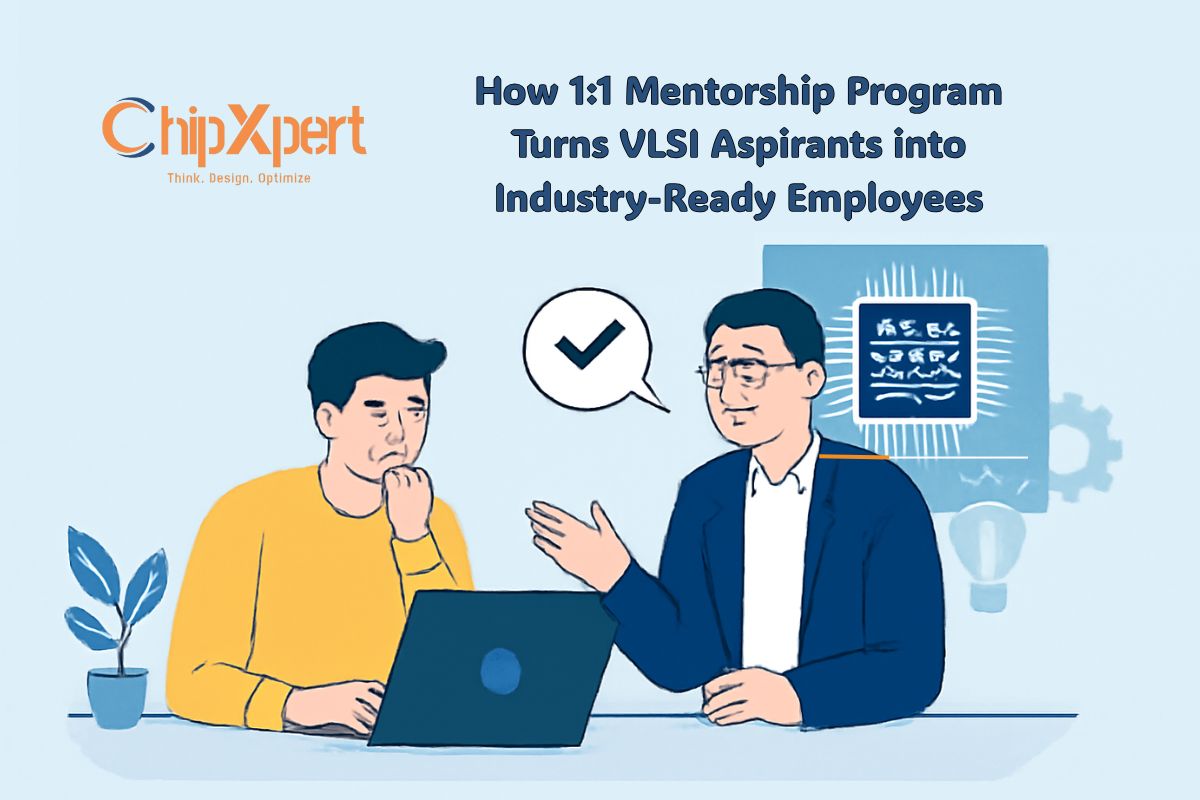How 1-1 Mentorship Program Turns VLSI Aspirants into Industry-Ready Employees
Introduction to VLSI and the Need for Mentorship
The Very Large Scale Integration (VLSI) industry is at the heart of modern electronics, powering everything from smartphones to AI systems. For aspiring engineers, breaking into this competitive field can be daunting. Academic knowledge alone often falls short of the practical skills and industry insights required to excel. This is where a 1-1 mentorship program becomes a game-changer, bridging the gap between theoretical learning and real-world expertise.
In this article, we’ll explore how personalized mentorship transforms VLSI aspirants into confident, industry-ready professionals through tailored guidance, hands-on experience, and career-focused strategies.
Why Choose a 1-1 Mentorship Program for VLSI?
Unlike traditional classroom training or online courses, a 1:1 mentorship program offers personalized attention, addressing the unique needs of each learner. Here’s why it stands out:
- Customized Learning Path: Mentors assess the aspirant’s strengths, weaknesses, and goals to create a tailored roadmap, ensuring efficient skill development.
- Industry-Relevant Skills: Mentors, often seasoned VLSI professionals, share practical insights into tools, methodologies, and trends like Verilog, VHDL, and ASIC design.
- Real-Time Feedback: Immediate feedback on projects and assignments helps aspirants refine their skills and avoid common pitfalls.
- Networking Opportunities: Mentors often connect mentees with industry professionals, opening doors to internships and job opportunities.
Key Benefits of 1-1 Mentorship in VLSI Training
A well-structured 1:1 mentorship program offers a range of benefits that prepare aspirants for the demands of the VLSI industry:
1. Hands-On Experience with Industry Tools
VLSI roles require proficiency in tools like Cadence, Synopsys, and Mentor Graphics. Mentors guide aspirants through real-world projects, ensuring they gain hands-on experience with these tools. For example, mentees might work on designing a digital circuit or simulating a chip layout, mimicking tasks performed in the industry.
2. Bridging the Gap Between Academia and Industry
Academic curricula often lag behind the fast-evolving semiconductor industry. Mentors provide up-to-date knowledge on topics like low-power design, System-on-Chip (SoC) architecture, and advanced fabrication processes, ensuring aspirants are industry-ready.
3. Soft Skills and Professional Development
Beyond technical expertise, mentors coach aspirants on essential soft skills like problem-solving, teamwork, and communication. They also provide guidance on resume building, interview preparation, and workplace etiquette, which are critical for securing and thriving in VLSI roles.
4. Confidence Building Through Real Projects
Completing real-world projects under expert supervision boosts confidence. For instance, designing a functional block of an integrated circuit or debugging a complex Verilog code gives aspirants a sense of accomplishment and readiness for professional challenges.
How 1:1 Mentorship Works: A Step-by-Step Process
A typical 1:1 mentorship program for VLSI aspirants follows a structured yet flexible approach:
- Initial Assessment: The mentor evaluates the aspirant’s background, skills, and career goals to design a personalized learning plan.
- Skill Development: The mentee learns core VLSI concepts, such as digital design, analog circuits, and verification techniques, through interactive sessions.
- Project-Based Learning: The mentor assigns projects that simulate real-world VLSI tasks, such as RTL coding or timing analysis.
- Regular Reviews: Weekly or bi-weekly check-ins ensure the mentee stays on track, with constructive feedback to improve performance.
- Career Guidance: The mentor provides job search strategies, mock interviews, and networking tips to help the mentee land their dream role.
Success Stories: From Aspirant to Industry Professional
Many VLSI professionals credit 1:1 mentorship for their success. For example, Priya, a recent graduate, struggled with understanding FPGA design. Through a mentorship program, she worked on a real FPGA project under her mentor’s guidance, mastering the skills needed to secure a role at a leading semiconductor company. Similarly, Arjun, an electronics engineer, transitioned from academia to a verification engineer role after his mentor helped him master UVM (Universal Verification Methodology) through targeted projects.
These stories highlight how personalized mentorship equips aspirants with the confidence and skills to thrive in the VLSI industry.
Tips for Choosing the Right VLSI Mentorship Program
To maximize the benefits of a 1:1 mentorship program, consider these factors:
- Mentor Expertise: Choose a mentor with proven industry experience in VLSI design, verification, or physical design.
- Program Structure: Look for programs offering hands-on projects, flexible schedules, and regular feedback.
- Reputation and Reviews: Research the program’s success rate and testimonials from past mentees.
- Career Support: Ensure the program includes resume reviews, interview prep, and industry connections.
Conclusion: Your Path to a Successful VLSI Career
A 1:1 mentorship program is a powerful tool for transforming VLSI aspirants into industry-ready employees. By offering personalized guidance, hands-on experience, and career-focused support, these programs empower learners to excel in the competitive semiconductor industry. If you’re an aspiring VLSI engineer, investing in a mentorship program could be the key to unlocking your potential and landing your dream job.
Ready to take the next step? Start exploring reputable 1:1 mentorship programs today and pave your way to a rewarding career in VLSI!



